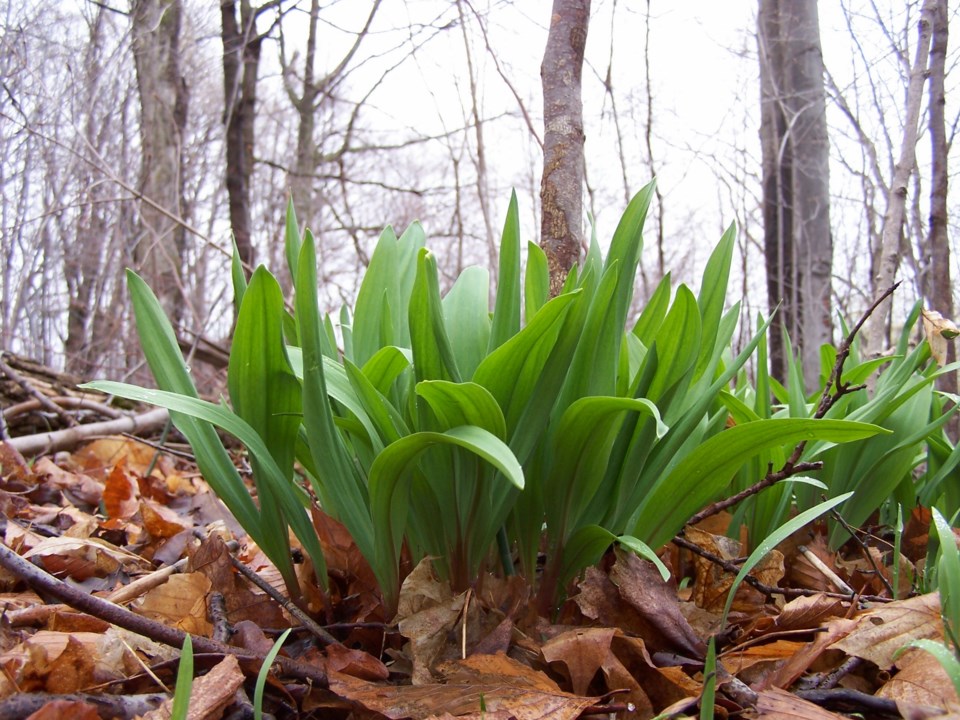When the word ‘harvest’ is used, it usually means a fall gathering of ripe fruit, nuts, berries or fattened game. But there is a spring harvest that is underway right now, and it is fraught with controversy. To pick wild or buy local, that is the question.
The species of concern are wild leeks and fiddleheads. Both are native species of local plants, and both are deemed just as important to spring tradition as the tapping of maple trees.
Wild leeks are also called ramps, the latter name coming from England and from the Appalachian area of the north-east United States. Since I live in neither of those places, I prefer to use the local moniker of wild leeks.
As they grow in the deciduous forest habitat that surrounds the Great Lakes, it is easy to see how the name has floated back and forth across the political border.
Labelled as being in the onion family, wild leeks certainly have a tangy bite to their flavour, and after a winter diet of salt pork, biscuits and porridge, I can imagine how welcome these plants were to the diet of early settlers. Of course, the Native peoples had been well aware of this delicacy for innumerable prior generations.
Black bears that have recently emerged from their long winter’s nap are quite hungry and wild leeks (and sedges) are an important part of their nutritional reloading. Deer nibble on the leaves, but not voraciously.
A wild leek takes about seven years of growing to produce a mature plant, one that sends up a flower stalk in hopes of producing seeds. Interestingly, the flowering structure appears long after the spring leaves have wilted and disappeared. This strategy is similar to that of trilliums, whereas the leaves must gather sunlight for energy prior to being shaded out by the maple tree canopy.
However, unlike the trilliums, the wild leeks focuses on one step at a time ... first gather the sunlight (via lush leaf growth), then later produce the flower, whereas the trilliums are over-achievers and try to do it all at once.
The controversy surrounding wild leeks is a human-based concern. The leaves and roots taste incredibly good! And few growers have the garden space or the soil and shade conditions to ‘grow yer own’ for a one-week harvest. And so the foragers swarm the countryside in search of leek beds.
A patch of wild leeks often has several plants clustered together, each with a single bulb. The twin leaves are just as edible as the root. There has been encouragement provided to foragers to pick only the leaf and then less than half of the patch. However, a picked leaf does not last long before it wilts, so beyond a trailside nibble there is still the yearning to dig up the roots.
The hardwood forests of the Gatineau Hills (surrounding Ottawa and Hull) were once green with wild leeks every spring. Now there are virtually none, and local laws are in place to ban leek harvesting.
What happened? Supply, demand, greed ... the hills were ravaged by pickers who had found willing buyers at the farmers' market. In short order, the bulbs were stripped from the woodland floor, leaving none to reproduce.
The other spring harvest currently underway is the gathering of fiddleheads, the newly emerging fronds of the ostrich fern. Also a great source of spring time nutrients, these plants have been utilized by bears and humans alike for many centuries. Named for the large fronds that look much like the decorative feathers of the ostrich bird, these ferns grow in abundance along stream sides and wet woods.
The fiddleheads are the tightly coiled new growth, and there are several to a root clump. Again, the advice is to pick sparingly, leaving enough for the plant to grow to maturity and spend the early summer gathering and storing that important sunlight energy.
Special note to foragers: pick only ostrich fern fiddleheads! All ferns are carcinogenic, and the other species have higher concentrations of the toxins. Even the ostrich fern fiddleheads must be boiled or steamed thoroughly before eating; unlike leeks, ferns must never be eaten raw.
The spring harvest of willow, birch and aspen catkins is best left to moose, bear and deer. These flowering structures also attract many pollinators, which in turn become food for migrating birds.
As you take a springtime wander, feel free to munch on a wild leek leaf or two (provided you don’t want close social connection with another for a while). The ‘season’ is short, only a couple of weeks, so get outside and enjoy all that the season has to offer.
